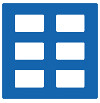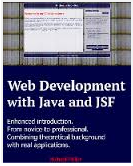<p:tabView>
<p:tab title="Rafael
Nadal">
<h:panelGrid columns="2"
cellpadding="10">
<p:graphicImage library="default"
name="images/rafa_l.jpg" width="70"
height="100"/>
<h:outputText value="Rafael 'Rafa'
Nadal Parera (born 3 June 1986) is a Spanish professional tennis player
currently ..." />
</h:panelGrid>
</p:tab>
<p:tab title="Novak Djokovic">
<h:panelGrid columns="2"
cellpadding="10">
<p:graphicImage library="default"
name="images/novak_l.jpg" width="70" height="100"/>
<h:outputText value="Novak Djokovic (born 22 May 1987) is a
Serbian professional tennis player who is currently ..." />
</h:panelGrid>
</p:tab>
<p:tab title="Roger Federer">
<h:panelGrid columns="2"
cellpadding="10">
<p:graphicImage
library="default" name="images/roger_l.jpg"
width="70" height="100"/>
<h:outputText value="Roger Federer (born 8 August 1981) is a
Swiss professional tennis player who is currently ..." />
</h:panelGrid>
</p:tab>
</p:tabView>
Now, this
will produce something like in figure below:
But, let's
suppose that we want something like this:
Well, the
below CSS will do the trick:
.ui-tabs-vertical
{
width: 60em;
height:38em;
}
.ui-tabs-vertical
.ui-tabs-nav {
padding: .2em .1em .2em .2em;
float: left;
width: 12em;
}
.ui-tabs-vertical
.ui-tabs-nav li {
clear: left;
width: 100%;
padding-top:120px;
background: url('#{resource["default:images/atp_d.png"]}');
background-repeat: no-repeat;
background-position: center;
border-top-width: 1px !important;
border-bottom-width: 1px !important;
border-right-width: 1px !important;
-webkit-transform: rotate(270deg);
-moz-transform: rotate(270deg);
-o-transform: rotate(270deg);
}
.ui-tabs-vertical
.ui-tabs-nav li a {
display:block;
padding-left: 30px;
/*
you ca apply rotate here, to rotate only the
text
of course, afterwards, you have to perform
the proper adjustments
-webkit-transform: rotate(270deg);
-moz-transform: rotate(270deg);
-o-transform: rotate(270deg);
*/
}
.ui-tabs-vertical
.ui-tabs-nav li.ui-tabs-selected {
background:
url('#{resource["default:images/atp_s.png"]}');
background-repeat: no-repeat;
background-position: center;
}
.ui-tabs-vertical
.ui-tabs-panel {
padding: 1em;
float: right;
width: 40em;
}
/* this will
affect the fonts of all PrimeFaces components */
.ui-widget {
font-family: Rockwell, 'Courier Bold',
Courier, Georgia, Times, 'Times New Roman', serif;
font-size: 12px;
font-style: normal;
font-variant: normal;
font-weight: 400;
line-height: 20px;
}
Do not
forget to attached the CSS code to the tab view:
<p:tabView
styleClass="ui-tabs-vertical">
...
</p:tabView>
Or, if you
need to obtain vertical tabs without pictures, as below:
Then you can
use this CSS code:
.ui-tabs-vertical
{
width: 50em;
height:50em;
-webkit-transform: rotate(270deg);
-moz-transform: rotate(270deg);
-o-transform: rotate(270deg);
}
.ui-tabs-vertical
.ui-tabs-panel {
float: left;
height:45em;
padding-left:30px;
-webkit-transform: rotate(90deg);
-moz-transform: rotate(90deg);
-o-transform: rotate(90deg);
}
Or, make a smaller one and place it in a PrimeFaces layout (center panel):
Most likely this snippet of CSS can be produced more optimal, so feel free to modify it accordingly.
.ui-tabs-vertical
{
width: 40em;
height:40em;
-webkit-transform:
rotate(270deg);
-moz-transform:
rotate(270deg);
-o-transform:
rotate(270deg);
}
.ui-tabs-vertical
.ui-tabs-panel
{
float:
left;
height:35em;
padding-left:30px;
-webkit-transform:
rotate(90deg);
-moz-transform:
rotate(90deg);
-o-transform:
rotate(90deg);
}
}
Most likely this snippet of CSS can be produced more optimal, so feel free to modify it accordingly.
Complete
code on GitHub.











 Arrays
Arrays Converters
Converters



 JSF 2 Tutorials at www.mkyong.com
JSF 2 Tutorials at www.mkyong.com  JavaServer Faces (JSF) Tutorial
JavaServer Faces (JSF) Tutorial 





















Niciun comentariu :
Trimiteți un comentariu